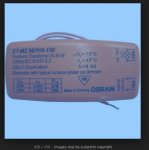180528-0854 EDT
ELA:
I agree that different peoples interest in different things are greatly varied. Many people here are more interested in getting the job done in order to move on to the next job. Others with time to spare may want to experiment driven by a need to know.
The problem presented in post #1 related to getting the job done.
I've put Green Creative LED MR-16 replacements in some line-voltage track lights. Surprisingly, the 50-watt transformer does power up the 8-watt lamp, but dimming is a real bummer (DVLV no, DVCL no, DVELV no). Has anyone tried this and come up with a solution?
I don't know what this statement means.
I believe it means the track is a 120 V 60 Hz power source, a 120 V dimmer of some sort feeds the track, and that there are fixtures in the track with a built in 50 W transformer (what kind of transformer?) (what output voltage?) (what kind of voltage, AC or DC?) (if AC what frequency?) (with some defined dimmer, and an incandescent lamp load, what varies at bulb terminals, and what is the dimming range?).
Stated dimmers don't work well with the Green Creative LED MR-16 bulb.
Data sheet for said LED is at
http://gc-lighting.com/wp-content/uploads/GREEN-CREATIVE-LED-CRISP-SERIES-MR16-7W-High-CRI.pdf
States 12 V 60 Hz. Nothing about means to dim, voltage or phase shift. Or whether it works on DC. Probably works on DC but dimming may not be good.
Dimmer compatibility chart is possibly useless, but is at
http://gc-lighting.com/wp-content/u...MR16_7W_High-CRI_LED_Dimmer_compatibility.pdf
What happens if a 60 Hz voltage source adjustable from 0 to 12 V is applied directly to the LED bulb? No discussion. This is an easy experiment. Use a Variac into a 120 to 12 V ordinary iron core transformer to the LED bulb. I have no idea what will happen. The GE MR-16 has a very poor dimming range. On DC 100 down to 80 %. AC is not much different.
Instead use a suitable phase shift dimmer at the said transformer input. Means it must be designed to work with an iron core transformer load. In turn this means essentially no DC component into the transformer primary, otherwise core saturation occurs. Now what is the satisfactory dimming range?
I can not assume the GE MR-16 works anything like the
Green Creative LED MR-16.
The Maxim chip you referenced appears primarily to be designed to make the electronic transformer think there is a heavier load than what is present.
In a different datasheet I found a driver chip for use in electronic transformers that produces an output frequency of about 35 kHz. So this is possibly what might be a typical AC output frequency.
.


